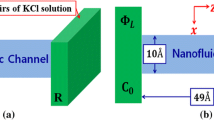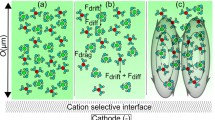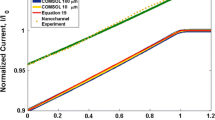Abstract
Electrokinetic fluid flow in nanocapillary array (NCA) membranes between vertically separated microfluidic channels offers an attractive alternative to using mechanical action to achieve fluidic communication between different regions of lab-on-a-chip devices. By adjusting the channel diameter, a, and the inverse Debye length, к, and applying the appropriate external potential, the nanochannel arrays, can be made to behave like digital fluidic switches, and the movement of molecules from one side of the array to the other side can be controlled. However, inherent differences in ionic mobility lead to non-equilibrium ion populations on the downstream side, which, in turn, shows up through transient changes in the microchannel conductance. Here we describe coupled calculations and experiments in which the electrical properties of a microfluidic–nanofluidic hybrid architecture are simulated by a combination of a compact model for the bulk electrical properties and iterative self-consistent solutions of the coupled Poisson, Nernst–Planck, and Navier–Stokes equations to recover the detailed ion motion in the nanopores. The transient electrical conductivity in the microchannel, after application of a forward bias pulse to the NCA membrane, is recovered in quantitative detail. The surface charge density of the nanopores and the capacitance of the membrane, which are critical determinants of electrokinetic flow through NCA, fall out of the analysis in a natural way, providing a clear mechanism to determine these critically important parameters.
Access this article
We’re sorry, something doesn't seem to be working properly.
Please try refreshing the page. If that doesn't work, please contact support so we can address the problem.
Similar content being viewed by others
References
R.S. Berry S.A. Rice J. Ross (1980) Physical Chemistry John Wiley Sons New York
D.M. Cannon T.-C. Kuo P.W. Bohn J.V. Sweedler (2003) ArticleTitleNanocapillary array interconnects for gated analyte injections and electrophoretic separations in multilayer microfluidic architectures Anal. Chem. 75 2224–2230 Occurrence Handle10.1021/ac020629f Occurrence Handle12918959
A.N. Chatterjee N.R. Aluru (2005) ArticleTitleCombined circuit/device modeling and simulation of integrated microfluidic systems J. Microelectromech. Sys. 14 81–95 Occurrence Handle10.1109/JMEMS.2004.839025
K.-Y. Chun P. Stroeve (2002) ArticleTitleProtein transport in nanoporous membranes modified with self-assembled monolayers of functionalized thiols Langmuir 18 4653–4658 Occurrence Handle10.1021/la011250b
B.B. Haab R.A. Mathies (1999) ArticleTitleSingle-molecule detection of DNA separations in microfabricated capillary array electrophoresis chips employing focused molecular streams Anal. Chem. 71 5137–5145 Occurrence Handle10.1021/ac990644t Occurrence Handle11419480
J. Han H.G. Craighead (2000) ArticleTitleSeparation of long DNA molecules in a microfabricated entropic trap array Science 288 1026–1029 Occurrence Handle10.1126/science.288.5468.1026 Occurrence Handle10807568
P.J. Kemery J.K. Steehler P.W. Bohn (1998) ArticleTitleElectric field mediated transport in nanometer diameter channels Langmuir 14 2884–2889 Occurrence Handle10.1021/la980147s
T.-C. Kuo H.K. Kim D.M. Cannon P.W. Bohn J.V. Sweedler (2004) ArticleTitleNanocapillary arrays effect mixing and reaction in multilayer fluidic structures Angew. Chem. Int. Ed. 43 1862–1865 Occurrence Handle10.1002/anie.200353279
T.-C. Kuo D.M. Cannon Y.N. Chen J.J. Tulock M.A. Shannon J.V. Sweedler P.W. Bohn (2003a) ArticleTitleGateable nanofluidic interconnects for multilayered microfluidic separation systems Anal. Chem. 75 IssueID8 1861–1867 Occurrence Handle10.1021/ac025958m
T.-C. Kuo D.M. Cannon M.A. Shannon P.W. Bohn J.V. Sweedler (2003b) ArticleTitleHybrid three-dimensional nanofluidic/ Microfluidic devices using molecular gates Sensons Actuators A 102 223–233 Occurrence Handle10.1016/S0924-4247(02)00394-1
Kuo T.-C., D.M. Cannon Jr., W. Feng, M.A. Shannon, J.V. Sweedler & P.W. Bohn, 2001. Three-dimensional fluidic architectures using nanofluidic diodes to control transport between microfluidic channels in microelectromechanical devices. Micro Total Analysis Systems 2001, Monterey CA, USA. October 2001, 60–62
T.-C. Kuo L.A. Sloan J.V. Sweedler P.W. Bohn (2001) ArticleTitleManipulating molecular transport through nanoporous membranes by control of electrokinetic flow: Effect of surface charge density and Debye length Langmuir 17 6298–6303 Occurrence Handle10.1021/la010429j
C. Lettmann D. Mockel E. Staude (1999) ArticleTitlePermeation and tangential flow streaming potential measurements for electrokinetic characterization of track-etched membranes J. Membr. Sci. 159 243–251 Occurrence Handle10.1016/S0376-7388(99)00067-8
Lurch E.N., 1971. Fundamentals of Electronics. John Wiley & Sons
A. Manz N. Graver H.M. Widmer (1990) ArticleTitleMiniaturized total chemical analysis systems-a novel concept for chemical sensing Sens. Actuat. B. 1 244–248 Occurrence Handle10.1016/0925-4005(90)80209-I
D. Mitchell S. Bok Lee L. Trofin N. Li K. Nevanen H. Söderlund C. Martin (2002) ArticleTitleSmart nanotubes for bioseparation and biocatalysis J. Am. Chem. Soc. 124 11864–11865 Occurrence Handle10.1021/ja027247b Occurrence Handle12358526
J.C. McDonald D.C. Duffy J.R. Anderson D.T. Chiu H.K. Wu O.A. Schueller G.M. Whitesides (2000) ArticleTitleFabrication of microfluidic systems in poly(dimethylsiloxane) Electrophoresis 21 27–40 Occurrence Handle10.1002/(SICI)1522-2683(20000101)21:1<27::AID-ELPS27>3.0.CO;2-C Occurrence Handle10634468
K.B. Oldham J.C. Myland (1994) Fundamentals of Electrochemical Science Academic Press Inc San Diego
R.F. Probstein (1994) Physiochemical Hydrodynamics Wiley New York
R. Qiao N.R. Aluru (2002) ArticleTitleA compact model for electroosmotic flows in microfluidic devices J. Micromech. Microeng. 12 625–635 Occurrence Handle10.1088/0960-1317/12/5/318
B.H. Vander Schoot S. Jeanneret A. Berg Particlevan den N.F. Rooij Particlede (1992) ArticleTitleA silicon integrated miniature chemical analysis system Sensors Actuators B 6 57–60 Occurrence Handle10.1016/0925-4005(92)80030-2
A.T. Woolley R.A. Mathies (1994) ArticleTitleUltra-high-speed DNA fragment separations using microfabricated capillary array electrophoresis chips Proc. Natl. Acad. Sci. USA 91 11348–11352 Occurrence Handle7972062
R.J. Wakeman E.S. Tarleton (1991) ArticleTitleAn experimental-study of electro-acoustic cross flow microfiltration Chem. Eng. Res. Des. 69 386–397
White F.M., 2002. Fluid Mechanics. McGraw-Hill
Author information
Authors and Affiliations
Corresponding author
Rights and permissions
About this article
Cite this article
Chatterjee, A., Cannon, D., Gatimu, E. et al. Modeling and Simulation of Ionic Currents in Three-Dimensional Microfluidic Devices with Nanofluidic Interconnects. J Nanopart Res 7, 507–516 (2005). https://doi.org/10.1007/s11051-005-5133-x
Received:
Accepted:
Issue Date:
DOI: https://doi.org/10.1007/s11051-005-5133-x




